Nestled in the tropical paradise of Australia’s Far North Queensland lies the magnificent Daintree Rainforest, the oldest rainforest in the world. This ancient rainforest is a living testament to the wonders of nature, and it is renowned for its exceptional biodiversity. Spanning over 1,200 square kilometres, the Daintree Rainforest is home to many unique and fascinating animals. In this blog, we will take you on a journey through this ecological wonderland, exploring some of the amazing animals you might encounter in this lush and vibrant landscape.
1. Southern Cassowary (Casuarius casuarius)
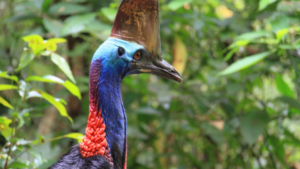
The Southern Cassowary is one of the most iconic and enigmatic creatures in the Daintree Rainforest. This large, flightless bird stands tall with striking blue skin on its head and a vivid casque on its crown. The cassowary plays a crucial role in seed dispersal, as it consumes various fruits and excretes the seeds in different locations, contributing to the forest’s regeneration.
Encountering a cassowary in the wild is a rare and awe-inspiring experience, but it’s essential to remember that these creatures are wild and can be dangerous if provoked. Always maintain a respectful distance and never feed them, as this can disrupt their natural behaviour.
2. Boyd’s Forest Dragon (Hypsilurus boydii)
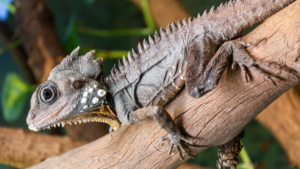
Among the ancient trees and leafy undergrowth, you might encounter the remarkable Boyd’s Forest Dragon. These reptiles possess an extraordinary ability to blend seamlessly into their environment, thanks to their intricate patterns and colouration.
Boyd’s Forest Dragons are arboreal, spending much of their time perched on tree branches or tree trunks. They are also known for their impressive displays during mating season, where males use their vivid colours and head-bobbing behaviour to attract potential mates.
3. Spotted-tailed Quoll (Dasyurus maculatus)
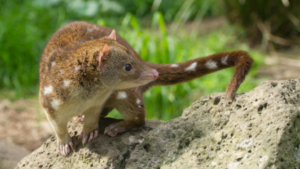
The Daintree Rainforest is not just home to an array of reptiles and birds but also harbours some elusive and fascinating mammals, such as the Spotted-tailed Quoll. This carnivorous marsupial, also known as the tiger quoll, is the largest remaining marsupial predator on the Australian mainland.
The Spotted-tailed Quoll’s distinctive spotted coat and sharp teeth make it an efficient hunter, preying on various small mammals, birds, and reptiles. Unfortunately, like many species, quoll populations have been threatened by habitat loss and introduced predators.
4. Ulysses Butterfly (Papilio ulysses)

Among the vibrant flora of the Daintree Rainforest, you’ll find equally colourful fauna, such as the Ulysses Butterfly. This striking blue butterfly is a sight to behold as it gracefully flutters through the forest, its wings reflecting iridescent hues in the sunlight.
The Ulysses Butterfly is a symbol of the Daintree Rainforest’s incredible diversity and serves as a gentle reminder of the delicate balance between wildlife and their environment.
5. White-lipped Tree Frog (Litoria infrafrenata)
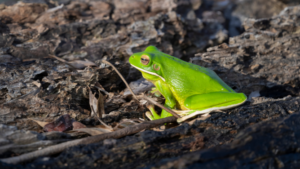
In the Daintree Rainforest, amidst lush vegetation and serene waterways, you might spot the striking White-lipped Tree Frog. This beautiful amphibian boasts a vibrant green colour that blends seamlessly with the foliage, providing excellent camouflage. Its large, round eyes with vertical pupils grant it superb night vision, aiding its nocturnal exploration.
The White-lipped Tree Frog’s powerful jumping ability is awe-inspiring. Using its long, muscular hind legs, it leaps from leaf to leaf, searching for food and suitable breeding grounds. During the rainy season, the males create a harmonious symphony of croaks, calling out to potential mates.
Beyond their enchanting appearance and captivating calls, these tree frogs serve a crucial role in the rainforest’s balance. Feeding primarily on insects and small invertebrates, they help control insect populations within the ecosystem.
6. Platypus (Ornithorhynchus anatinus)
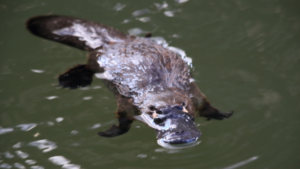
In the waterways of the Daintree Rainforest, an enigmatic creature dwells—the Platypus. This unique mammal possesses a sleek body, webbed feet, and a duck-like bill with electroreceptors to sense prey movements underwater. Primarily nocturnal, it feeds on aquatic invertebrates and small fish. Female Platypuses lay eggs and nurse their young with specialised mammary glands, making them one of the few egg-laying mammals known as monotremes.
Sadly, habitat loss and human interference threaten Platypus populations, making conservation efforts crucial for their survival.
The Daintree Rainforest is a living testament to the importance of preserving Earth’s most ecologically diverse regions. Within its lush canopy and vibrant undergrowth, an array of unique and fascinating animals call this ancient rainforest home. From the iconic Southern Cassowary to the elusive Spotted-tailed Quoll, the Daintree’s residents showcase the beauty and wonder of nature.
As visitors to this ecological wonderland, it’s vital to tread lightly, respecting the delicate balance of this intricate ecosystem. By valuing and protecting the Daintree Rainforest and its inhabitants, we ensure that future generations can also revel in the awe-inspiring diversity of this breathtaking landscape.
